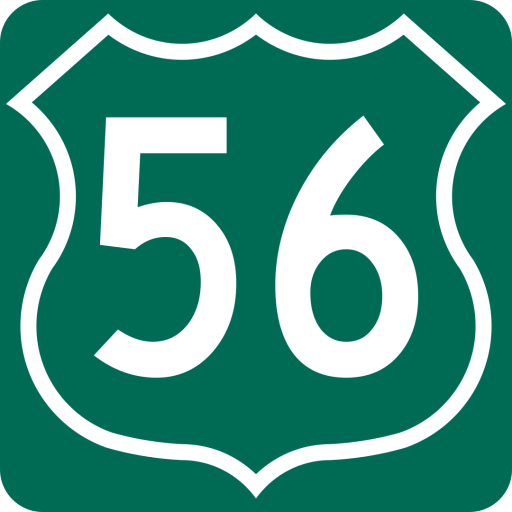K-1
Length: 13.363 miles
South Endpoint: OK 34 at the Oklahoma State Line
North Endpoint:
US 83 near Woodruff (1926-1941)
US 160–183 south of Coldwater. (1941-present)
County Served: Comanche
Historical Counties Served:
Kiowa, Edwards, Pawnee, Rush, Ellis, Rooks, Phillips (1926-1941)
History
K-1 originally ran north from Comanche through Greensburg, Kinsley, La Crosse, Hays, Stockton, and Philipsburg before reaching K-22, later US 83, near the Nebraska Border. The number was chosen in deference to the connecting Oklahoma highway.
In 1927, K-1 was gravel from La Crosse north to the Rush-Ellis County Line, and dirt along the rest of the route. By 1932, K-1 had been graveled between US 160 at Coldwater and US 54 at Greensburg, between US 50S at Kinsley and US 50N at Rozel, between Rush Center and La Crosse, and in the southern two-thirds of Ellis County, including through Hays.
By 1938, the remaining dirt segments of K-1 had been graveled. The gravel road between Coldwater and Greensburg, between Lacrosse and Hays, and between the Ellis/Rooks County line and K-18 at Plainville had been upgraded to a hard-surface road
In the fall of 1938, US 183 was extended south, following K-1 between the junction with US 160 south of Comanche and the intersection with US 36 at Phillipsburg. By the fall of 1941, the alignments of US 83 and US 183 were switched north of US 36, and all of K-1 north of US 160 was re-designated as US 183. At the time of the re-designation, only the Kinsley-Rozel segment and the surviving segment between the Oklahoma State Line and US 160 remained gravel. The surviving segment of K-1 was hard-surfaced by 1953.
Junction Guide
| KDOT Milepost | Total Miles | Junction |
|---|---|---|
| 1-17/0.000 | 0.000 | Oklahoma State Line |
| 1-17/4.454 | 4.454 | Avenue W |
| 1-17/13.363 | 13.363 | US 160/US 183 |
AADT (2023)
| Location | Count | Truck % |
|---|---|---|
| State Line to Avenue W | 477 | 47.8% |
| Avenue W to US 160/US 183 | 575 | 47.7% |
K-2
Length: 61.516 miles
Southwest Endpoint:
Junction US 160 in Harper (1937-1962)
Junction US 281 west of Kiowa (1962-present)
Northeast Endpoint:
Junction K-42 in Norwich (1937-1950)
Junction US 54 in Wichita, concurrent with K-42 (1963-1994)
Junction K-42 east of Norwich (1950-1963; 1994-present)
Counties Served:
Barber, Harper, Kingman, Sumner
Historical County Served:
Sedgwick (1963-1994)
History
The second K-2 was designated in a January 7, 1937 highway commission resolution, starting at US 160 near Harper, heading on a northeastward path an new gravel alignment along the south side of the Kansas City, Mexico, and Orient Railroad, then curving north along an existing section-line road to meet K-42 in Norwich. Apparently, the project was not fully completed before World War II broke out, as K-2 was routed east along an existing road on the Kingman/Harper county line before turning north into Norwich, which had degraded into dirt by 1945. In 1950, the uncompleted curve south of Norwich was replaced by an extension of the diagonal route to meet K-42 3 miles east of Norwich, and one mile east of the Sumner/Kingman County Line. The Harper County segment was paved at the same time the new diagonal was completed.
By 1963, K-2 was extended west in an concurrency with K-14 from Harper to US 281 west of Kiowa. By 1963 K-2 had been extended east, concurrent with K-42, all the way to US 54 in Wichita.
In late 1994, the K-2/K-14 and K-2/K-42 dual designations were deemed to serve no purpose, confusing to travelers, and costly in terms of sign maintenance. KDOT elected to remove K-2 from K-42, truncating K-2’s east end back to Norwich; and removed K-14 south of Harper, leaving K-2’s west end at US 281.
Junction Guide
| KDOT Milepost | Total Miles | Junction |
|---|---|---|
| 2-4/0.000 | 0.000 | US 281 |
| 2-4/4.223 | 4.223 | West city limits Kiowa |
| 2-4/4.511 | 4.511 | K-8 |
| 2-4/4.729 | 4.729 | 7th/Main, Kiowa |
| 2-4/5.168 | 5.168 | Barnes Street, Kiowa |
| 2-4/5.267 | 5.267 | North city limits Kiowa |
| 2-4/11.250 | 11.250 | West city limits Hazelton |
| 2-4/11.458 | 11.458 | Main Street, Hazelton |
| 2-4/11.777 | 11.777 | North city limits Hazelton |
| 2-4/16.331 2-39/0.000 | 16.331 | Barber/Harper county line |
| 2-39/17.355 | 33.686 | K-42, Anthony |
| 2-39/23.369 160-39/17.589 | 39.700 | South junction US 160 |
| 160-39/20.604 | 42.715 | K-14, west city limits Harper |
| 160-39/21.716 2-39/27.496 | 43.827 | North Junction US 160 |
| 2-39/28.102 | 44.433 | North city limits Harper |
| 2-39/28.807 | 45.138 | NE 100 Road |
| 2-39/38.106 2-48/0.000 | 54.437 | Harper/Kingman county line |
| 2-48/2.750 | 57.187 | SE 150 Avenue, Kingman County |
| 2-48/5.613 2-96/0.000 | 60.050 | Kingman/Sumner County line |
| 2-96/1.466 | 61.516 | K-42 |
AADT (2021)
| Location | Count | Truck % |
|---|---|---|
| US 281 to MP 2 | 1,100 | 13.6% |
| MP 2 to west city limits Kiowa | 885 | 18.1% |
| West city limits Kiowa to K-8 | 1,660 | 9.0% |
| K-8 to 7th/Main, Kiowa | 2,320 | 6.5% |
| 7th/Main to Hopkins Street | 1,350 | 7.4% |
| Hopkins Street to North city limits Kiowa | 1,060 | 12.3% |
| NCL Kiowa to MP 6.1 | 680 | 17.8% |
| MP 6.1 to Main Street, Hazelton | 535 | 17.8% |
| Main Street, Hazelton to NW/SW 140 Avenue, Harper County | 500 | 19.0% |
| NW/SW 140 Ave MP 30 | 680 | 14.0% |
| MP 30 to K-44, Anthony | 1,170 | 9.8% |
| K-44 to MP 37 | 3,970 | 8.4% |
| MP 37 to US 160 | 1,910 | 18.3% |
| On US 160 from South junction US 160/K-2 to K-14, Harper | 3,850 | 11.8% |
| On US 160 from K-14 to Ash Street, Harper | 4,560 | 12.6% |
| On US 160 from Ash Street to Washington Street, Harper | 4,990 | 10.1% |
| On US 160 from Washington Street to east junction US 160/K-2 | 4,640 | 11.2% |
| US 160 to north city limits Harper | 2,310 | 13.9% |
| NCL Harper to NE 100 Road, Harper County | 2,220 | 14.9% |
| NE 100 Road, Harper County to SE 150 Avenue, Kingman County | 2,410 | 14.1% |
| SE 150 Avenue to K-42 | 2,230 | 13.0% |
K-2 (1926-1930)
West Endpoint:
CO 102 at the Colorado State Line west of St. Francis.
East Endpoint:
Junction K-22
at Norton
Historic Counties Served:
Cheyenne, Rawlins, Decatur, Norton
K-3
Length: 43.262 miles
South Endpoint:
Junction K-47 6 miles west of Girard
North Endpoint:
K-38 north of Xenia (1926-1932)
K-31 3 miles west of Blue Mound (1932-present)
Counties Served:
Crawford, Bourbon, Linn
History
K-3 was numbered as part of a rough grid pattern of north-south highways. The first three miles of the highway, from the Mission Road south of Brazilton north, was graded and gravelled in 1924. In 1927, the highway was gravelled from Brazilton north to the Crawford-Bourbon County line.
In 1931, the route was gravelled from US 54 at Bronson north to west of Xenia, and a new gravel alignment was constrcted continuing north to K-38 west of Blue Mound. Once the new highway was opened, the old section passing through Xenia was redesignated as K-69.
The segment between K-57 and Hepler was paved by 1950, between Hepler and K-39 by 1953, and the rest was completed by 1957.
Junction Guide
| KDOT Milepost | Total Miles | Junction |
|---|---|---|
| 3-19/0.000 | 0.000 | K-47 |
| 3-19/3.015 | 3.015 | 650th Avenue |
| 3-19/6.406 | 6.406 | K-146 |
| 3-19/10.203 | 10.203 | South city limits Hepler |
| 3-19/11.209 | 11.209 | North city limits Hepler |
| 3-19/11.467 3-6/0.000 | 11.467 | Crawford/Bourbon county line |
| 3-6/3.010 | 14.477 | East junction K-39 |
| 3-6/3.514 | 14.981 | West junction K-39 |
| 3-6/12.543 | 24.010 | South city limits Uniontown |
| 3-6/12.697 | 24.164 | North city limits Uniontown |
| 3-6/13.567 54-6/6.326 | 25.034 | East junction US 54 |
| 54-6/1.137 3-6/18.756 | 30.223 | West junction US 54 |
| 3-6/25.765 | 37.232 | K-65 |
| 3-6/28.265 | 39.732 | Yellowstone Road |
| 3-6/28.795 3-54/0.000 | 40.262 | Bourbon/Linn county line |
| 3-54/3.000 | 43.262 | K-31 |
AADT (2023)
| Location | Count | Truck % |
|---|---|---|
| K-47 to 650th Avenue | 841 | 9.4% |
| 650th Avenue to K-146 | 641 | 11.4% |
| K-146 to Hepler | 616 | 14.8% |
| In Hepler | 528 | 21.0% |
| Hepler to K-39 | 441 | 15.6% |
| K-3/K-39 concurrency | 1,108 | 21.8% |
| K-39 to Uniontown | 590 | 17.1% |
| Uniontown to US 54 | 903 | 12.5% |
| US 54/K-3 concurrency | 1,436 | 24.2% |
| US 54 to K-65 | 569 | 12.5% |
| K-65 to Yellowstone Road | 492 | 28.9% |
| Yellowstone Road to K-31 | 472 | 22.7% |

K-4
Length: 369.079 miles
West Endpoint:
US 83 North of Scott City
East Endpoint:
Missouri State Line, Atchison (1927-1994; concurrent with US 59 after 1934)
US 59 Southeast of Nortonville (1994-present)
Counties Served:
Scott, Lane, Ness, Rush, Barton, Rice, Ellsworth, McPherson, Saline, Dickinson, Morris, Wabaunsee, Shawnee, Jefferson
Historic County Served:
Atchison (1926-1994)
(More…)
K-4 Alternate
Length: 1.027 miles
South Endpoint: K-4 South of Nortonville
Northeast Endpoint: US 59 east of Nortonville, concurrent with US 159
County Served: Jefferson
History
In 1981, KDOT redefined the US 159 designation in Nortonville. The stretch of US 159 from Walnut Street to the southern end of the Nortonville bypass was redesignated as K-4 Alternate, while the alternate route of US 159 on Walnut Street was redesignated as US 159/K-4 Alternate.
Junction Guide
| KDOT Milepost | Total Miles | Junction |
|---|---|---|
| 4A-44/0.000 | 0.000 | K-4 |
| 4A-44/0.551 159-44/0.476 | 0.551 | US 159 |
| 159-44/0.000 | 1.027 | US 59 |
AADT (2023)
| Location | Count | Truck % |
|---|---|---|
| K-4 to US 159 | 868 | 6.9% |
| US 159 to US 59 | 494 | 13.6% |
K-5
Southeast Endpoint:
proposed US 60 west of Galena (proposed 1925)
US 69 in Kansas City
Northwest Endpoint:
Nebraska State line north of Reserve (proposed 1925)
Junction US 73/K-7 In Leavenworth
Counties Served:
Wyandotte, Leavenworth
History
The original proposal for K-5 called for it to be a cross-state highway along the easternmost tier of Kansas counties. In the final Kansas highway numbering plan, K-5 was replaced by US 73E and US 73, except for a short segment between Galena and Crestline, which became part of K-96, and a the segment between Kansas City and Lansing via Wolcott, which became the route for K-5 in the final 1926 numbering plan.
K-5 was paved in Wyandotte County by 1932. The Leavenworth County segment was graveled by 1933 and paved by 1941.
The construction of Wyandotte County Lake caused a gap in the original K-5 route. A new alignment around the west side of the lake was posted as “Detour K-5,” with the unaffected part of the old alignment maintained by the state. The detour lasted until I-435 was completed in the area by 1987, and K-5 was re-routed on 435 between Wolcott Drive and Leavenworth Road.
I-635 was originally planned to turn east just north of K-5, meet US 69, then turn north and cross into Missouri on the Fairfax. By 1969, the plans were changed so that 635 crossed the Missouri River on a new bridge. To compensate for the relocation of I-635, a spur to the Fairfax District was constructed. The new freeway was completed around 1976, and was subsequently designated as K-5.
Junction Guide
| KDOT Milepost | Total Miles | Junction |
|---|---|---|
| 5-105/0.000 | 0.000 | US 69/7th Street, Kansas City |
| 5-105/2.242 635-105/7.828 | 2.242 | East junction I-635 |
| 635-105/7.126 5-105/2.944 | 2.944 | West junction I-635 |
| 5-105/11.009 435-105/7.149 | 11.009 | South junction I-435 |
| 435-105/10.145 5-105/14.005 | 14.005 | North junction I-435 |
| 5-105/16.512 5-52/0.000 | 16.512 | Wyandotte/Leavenworth county line |
| 5-52/6.605 | 23.117 | East city limits Lansing |
| 5-52/7.001 | 23.513 | North city limits Lansing; South city limits Leavenworth |
| 5-52/7.560 | 24.072 | US 73/K-7, Leavenworth |
AADT (2021)
| Location | Count | Truck % |
|---|---|---|
| US 69 to 10th Street | 6,090 | 14.2% |
| 10th Street to I-635 | 6,970 | 13.8% |
| On K-5/I-635 concurrency | 49,500 | 12.0% |
| Leavenworth Road, I-635 to 59th Street | 10,700 | 2.5% |
| Leavenworth Road, 59th Street to 87th Street | 7,760 | 3.4% |
| Leavenworth Road, 87th Street to 99th Street | 5,790 | 4.6% |
| Leavenworth Road, 99th Street to I-435 | 6,780 | 3.9% |
| On I-435 from Leavenworth Road to Donahoo Road | 34,600 | 9.0% |
| On I-435 from Donahoo Road to Exit 18 | 31,900 | 9.6% |
| 97th Street, I-435 to Hutton Road | 3,470 | 7.9% |
| From 97th Street/Hutton Road to SCL Lansing | 2,200 | 9.1% |
| From SCL Lansing to US 73/K-7 | 2,080 | 8.7% |
K-6
South Endpoint:
Oklahoma state line south of Chetopa (proposed late 1925)
US 59 at Erie (1926-1960)
North Endpoint:
K-7 at Osawatomie (1926-1935)
US 54/K-52 near Welda (1935-1960)
Historic Counties Served:
Labette, Neosho, Allen (1926-1960)
Anderson, Franklin, Miami (1926-1935)
History
In the 1925 highway numbering proposal, the route from Oklahoma State Highway 6 south of Chetopa to K-7 at Osawatomie was initially designated K-9 as part of a “grid pattern” of north-south highways. At some point, the proposed K-6 and K-9 designations were switched to allow route continuity with the Oklahoma highway. Ironically, after the route designations were switched, the Oklahoma segment was re-designated as US 73. The 1926 initial designation of K-6 started from US 73W at Erie.
K-6 was a dirt road from Greeley to Osawatomie, hard surfaced from Elsmore to Mildred, and gravel along the rest of the route. Hard-surfacing had extended from Mildred to Kincaid by 1933. In 1934, US 73W was re-designated as US 59, the segment of K-6 from Moran to Kinkaid was re-designated K-52, the segment between Kincaid was re-designated K-31, and the segment between Garnett and Osawatomie was re-designated K-16.
By 1940, K-6 had been aligned on a new route, with the new K-6 running north from US 59 at Erie to K-39, then east on K-39 to Stark. The segment between K-39 and Stark was paved by 1940, and from Stark to Elsmore by 1945.
By 1950, US 59 had been moved to the north. The segment between Erie and K-39 was re-designed as US 59/K-6 and had been hard-surfaced.
K-6 had been re-designated as US 59 in its entirety by 1962.
K-6 (1925)
Proposed West Endpoint: K-22 in Selden
Proposed East Endpoint: Junction K-4 at Atchison
Proposed Counties Served:
Sheridan, Decatur, Norton, Phillips, Smith, Osborne, Mitchell, Cloud, Washington, Marshall, Nemaha, Jackson, Atchison
History
In the 1925 highway numbering proposal, K-6 was designated from Dresden to Atchison as part of a “grid pattern” of east-west highways. At some point, before the numbering plans were finalized, the proposed K-6 and K-9 designations were switched to allow K-6 to connect to Oklahoma 6.
Although the addition of US 73 and US 73W rendered the K-6/OK 6 continuity unnecessary, the final plan maintained the Dresden to Atchison highway as K-9.

K-7
Length: 243.984 miles
South Endpoint:
Oklahoma State Line, north of Picher, Oklahoma (concurrent with US 69 since 1935)
North Endpoint:
Junction US 40 in Bonner Springs (1926-1935)
Nebraska State Line north of White Cloud (1935-present)
Counties Served:
Cherokee, Crawford, Bourbon, Linn, Miami, Johnson, Wyandotte, Leavenworth, Atchison, Doniphan
K-8
Length: 15.963 miles
South Endpoint:
Oklahoma State Line south of Kiowa (1926-1940)
Junction US 36 West of Athol (1940-present)
North Endpoint:
NE 10 at the Nebraska State Line (CG/JJW) south of Franklin, Neb.
County Served:
Smith
Historic Counties Served:
Barber, Pratt, Stafford, Barber, Russell, Osborne (1926-1940)
History
The initial Kansas Highway numbering plan identified K-8 as a extension of Oklahoma State Highway 8, stretching from the Oklahoma/Kansas state line to US 36 in Smith Center. In the definitive plan, the segment extending from US 36 at Athol northward to Nebraska Highway 10 was included. The stretch from Oklahoma to Pratt was designated as the “Carrie Nation Trail” on the 1919 “Hockaday” map, while the rest of the route was not labeled as a Named Highway.
By 1932, most of the road was still dirt, with gravel segments between US 50N at Great Bend and K-4 at Hosington and between Osborne and Portis. By 1933, K-8 was gravel between the Oklahoma line and Medicine Lodge, between Saint John and Great Bend, between Waldo and Luray, and between Portis and Smith Center. In addition, the segment between Great Bend and Hosington was hard-surfaced. By 1936, K-8 had been gravelled between Sawyer and Saint John and between Hoisington and Russel, with the Portis-Smith Center segment sealed. By 1937, K-8 had been hard-surfaced between Pratt and Saint John, between the Stafford/Barton county line and Great Bend, and from Osborne to Portis.
Around 1940, K-8 between Smith Center and Kiowa was re-designated as US 281. The segment between Smith Center and the Nebraska line retained the K-8 designation, while the segment between the Oklahoma line and Kiowa was designated K-11 At the time of the change, K-8/US 281 had been hard surfaced between the Barton/Russell County line and Russell, and between Saint John and the Stafford/Barton county line.
Part of the northern segment of K-8, out of Athol, was gravelled by 1941. The remainder of the road remained dirt until the entire northern segment was paved by 1950.
AADT (2023)
| Location | Count | Truck % |
|---|---|---|
| US 36 to 60 Road (MP 11.000) | 640 | 25.7% |
| 60 Road to the Kansas/Nebraska state line | 727 | 28.3% |
K-8 (Southern Segment)
Length: 1.275 miles
South Endpoint:
OK 8 at the Oklahoma State Line South of Kiowa
North Endpoint:
Junction K-2 in Kiowa
County Served:
Barber
Junction Guide
| KDOT Milepost | Total Miles | Junction |
|---|---|---|
| 8-4/0.000 | 0.000 | Oklahoma state line |
| 8-4/0.676 | 0.681 | South city limits Kiowa |
| 8-4/1.275 | 1.275 | K-2 |
AADT (2023)
| Location | Count | Truck % |
|---|---|---|
| Oklahoma State Line to Kiowa | 913 | 16.5% |
| South City limits Kiowa to K-2 | 1,149 | 12.4% |

K-9
Length: 317.937 miles
West Endpoint:
Junction US 83 in Dresden (1926-1953)
Junction K-123 South of Dresden (1953-present)
East Endpoint:
Junction K-7 in Atchison, concurrent with US 73 (1926-1995)
Junction US 73 near Lancaster (1995-present)
Counties Served:
Sheridan, Decatur, Norton, Phillips, Smith, Osborne, Mitchell, Cloud, Washington, Marshall, Nemaha, Jackson, Atchison
K-9 (1925)
Proposed South Endpoint: Oklahoma state line south of Chetopa
Proposed North Endpoint: Junction K-7 in Osawatomie
Proposed Counties Served:
Labette, Neosho, Allen, Anderson, Franklin, Miami
History
In the 1925 highway numbering proposal, K-9 was designated from Chetopa to Osawatomie as part of a “grid pattern” of north-south highways. At some point, before the numbering plans were finalized, the proposed K-6 and K-9 designations were switched to allow K-6 to connect to Oklahoma 6.
Although the addition of US 73 and US 73W rendered the K-6/OK 6 continuity unnecessary, the final plan maintained the K-6 designation over the segment of the route that was not made part of the US highway.

K-10
Length: 36.611 miles
West Endpoint:
US 50N at Herrington (1926-1956)
US 40, 6th and Iowa Street, Lawrence (1956-1996)
I-70/Kansas Turnpike Exit 197 northwest of Lawrence (1996-present)
East Endpoint:
Missouri State Line, Kansas City (1926-1984)
I-435 exit 1B (de facto)/I-35 exit 222 (de jure) in Lenexa (1984-present)
Counties Served:
Douglas, Johnson
Historical Counties Served:
Dickinson, Morris, Wabaunsee, Shawnee (1926-1956)
Jefferson (1926-1935)
Wyandotte (1926-1984)
K-11
Length: 16.662 miles
South Endpoint: Junction US 54–400 west of Kingman.
North Endpoint: Junction K-61 southwest of Arlington
Counties Served: Kingman, Reno
Junction Guide
| KDOT Milepost | Total Miles | Junction |
|---|---|---|
| 11-48/0.000 | 0.000 | US 54 |
| 11-48/4.958 | 4.958 | 50th Street |
| 11-48/5.958 11-78/0.000 | 5.958 | Kingman/Reno county line |
| 11-78/3.013 | 8.971 | Pretty Prairie Road |
| 11-78/10.704 | 16.662 | K-61 |
AADT (2021)
| Location | Count | Truck % |
|---|---|---|
| US 54 to NW 50th Street | 420 | 7.1% |
| NW 50th Street to Pretty Prairie Road | 340 | 8.8% |
| Pretty Prairie Road to K-61 | 385 | 7.8% |
K-11 (1926-1938)
South Endpoint:
Oklahoma State Line in Elgin (1927-1936)
Oklahoma State Line South of Chautauqua (1936-1938)
North Endpoint:
NE 65 at the Nebraska State Line north of Summerfield
Historic Counties Served:
Chautauqua, Elk, Greenwood, Lyon, Wabaunsee, Pottawatomie, Marshall
K-11 (1940-1959)
South Endpoint: Oklahoma State Line South of Kiowa
North Endpoint: Junction K-14 in Kiowa.
Historic County Served: Barber
K-12
Length: 15.321 miles
Southwest Endpoint:
Junction K-7 north of Olathe (proposed 1965-1983)
Junction K-7 on Shawnee Mission Parkway in Shawnee (1984-1987)
Northeast Endpoint:
Junction I-35/I-435 in Lenexa (proposed 1965-1983)
Missouri State Line on Southwest Blvd, Kansas City (1984-1987)
Historic Counties Served: Johnson, Wyandotte
History
K-12 was initially designated in 1965 for a proposed freeway from I-35 and I-435 west to K-7 along 103rd Street to connect with a future extension of K-10.
Although the proposed K-12 was designated first, it was the last part of the Lawrence-Kansas City freeway to begin construction in 1980. Grading was completed by August of 1982 when work on the highway was suspended.
In December of 1983, KDOT switched the designations of K-10 and K-12 east of K-7. A year later, the new freeway between K-7 and I-435 was opened as K-10, and the original K-10 between K-7 and the Missouri line was officially re-designated as K-12
In 1983, only the westernmost 85 feet of K-12 was in rural Johnson County, with the remainder within the city limits of Shawnee, Merriam, and Kansas City. By 1987, Shawnee had annexed out past K-7. With the entire route urbanized, K-12 was turned back to the respective cities and removed from the State Highway system.
K-12 Spur (1984-1987)
West Endpoint:
Junction K-12 at Shawnee Mission Parkway and Merriam Lane
East Endpoint: Junction I-35 and Shawnee Mission Parkway
Historic County Served:
Johnson
History
When K-10 east of K-7 was re-designated as K-12, the short segment of the Shawnee Mission Parkway connecting Merriam Drive to I-35 was re-designated as a spur of K-12 from a spur of K-10. The designation was removed from the highway system in 1987 along with its parent.
K-12 (1925 proposal)
Proposed West Endpoint:
US 40 at Leonardville, concurrent with US 77
Proposed East Endpoint: K-4 at Valley Falls
Proposed Counties Served: Pottawatomie, Jackson, Jefferson
History
In the first draft of the Kansas highway numbering plan, the highway from Leonardville to Valley Falls via Onaga and Holton was to have been designated as highway 12. This designation would have been designated as part of a rough grid of east-west highways.
Changes in the US highway system proposal affected this highway’s final designation. The addition of US 24 and US 36 in Missouri resulted in changes to the Missouri Highway system. Missouri Highway 24 was re-numbered MO 52 and the connecting Kansas Highway was changed from 24 to 56. MO 36 was renumbered MO 12, and the K-12 designation was moved there. The number 24 was backfilled to become the designation of this highway when the Kansas Highway numbering plan was finalized.
K-12 (1926-1937)
West Endpoint:
Junction K-27 at Elkhart (1927-1928)
Junction K-27 at Richfield (1928-1937)
East Endpoint:
Missouri State Line East of Frontenac (1927-1930)
Junction US 83 north of Liberal (1930-1937)
Historic Counties Served:
Morton, Stevens, Meade (1927-1937)
Clark, Comanche, Kiowa, Barber, Harper, Sumner, Cowley, Chautauqua, Montgomery, Labette, Cherokee (1927-1930)
History
In the early drafts of the state highway system, this cross-state route was designated K-36 to match the connecting Missouri highway. As a result of the addition of US 36 to the US numbered system, Missouri re-designated its highway 36 as MO 12, and Kansas changed the designation on its side accordingly.
In 1930, a new US highway, US 160 was designated, supplanting K-12 east of US 83. The segment between Richfield and US 83 remained until it was re-designated as an extension of K-51 in 1937.
K-12 (1940-1950)
Historic West Endpoint:
Junction US 66 in Baxter Springs
Historic East Endpoint:
Missouri State Line East of Baxter Springs
Historic County Served:
Cherokee
History
The K-12 designation was revived for a new highway between US 66 and the State Border in the southeast corner of the state. Starting out as a dirt road, the highway was quickly hard-surfaced. By 1950, Missouri had connected this roadway into Joplin, and the road was re-designated as an extension of US 166.
K-13
Length: 14.617 miles
South Endpoint:
Junction US 77 Near Degraff (1926-1932)
Junction US 77 Near El Dorado (1932-1964)
Junction US 24 in Manhattan, concurrent with US 24/K-177 (1964-1991)
Junction US 24 Northwest of Rocky Ford (1991-present)
North Endpoint:
Junction US 40 near Manhattan (1926-1933)
Junction K-9 near Barrett (1933-1961)
Junction K-16 South of Fostoria (1961-present)
Counties Served: Riley, Pottawatomie
Historic Counties Served:
Butler, Chase, Morris, Geary (1926-1964)
Marshall (1933-1961)
History
K-13 originally ran from US 77 near DeGraff through Cassoday, Cottonwood Falls, Council Grove, and Alta Vista to US 40 near Manhattan. Only the section between Matfield Green and Strong City was gravel.
By 1932, the south end was moved from DeGraff to El Dorado. By 1933, the segment between El Dorado and Matfield Green was graveled and was extended north along a new alignment along the Blue River, crossing the Blue River at Garrison and continuing northeast to K-9 near Barrett. The portion south between Garrison and K-9 was gravel, the remainder remained dirt.
By 1936, K-13 had been graveled from Council Grove to Alta Vista and from Manhattan to Garrison. The entire route was gravel by 1945. By 1950, 13 had been hard-surfaced between Strong City and Alta Vista and between Manhattan and Garrison. By 1953, it was hard-surfaced from the new “straight shot” north to Manhattan. By 1956, the only sections not hard-surfaced were from Strong City north to the Butler/Morris county line, for a short stretch near Alta Vista, and from the junction with K-16 near Randolph to the north end at Barrett.
The filling of the Big Blue River Valley for Tuttle Creek Lake in 1962 flooded K-13 north of Manhattan. As a consequence, K-13 was realigned, heading north from Manhattan across the Tuttle Creek Dam, then northeast to K-16 near Fostoria.
By 1965, K-13 south of Manhattan was re-designated as K-177.
Junction Guide
| KDOT Milepost | Total Miles | Junction |
|---|---|---|
| 13-81/0.000 | 0.000 | US 24 |
| 13-81/0.976 13-75/0.000 | 0.976 | Riley/Pottawatomie county line |
| 13-75/1.214 | 2.190 | Dyer Road |
| 13-75/4.441 | 5.417 | Carnahan Road |
| 13-75/13.641 | 14.617 | K-16 |
AADT (2019)
| Location | Count | Truck % |
|---|---|---|
| US 24 to Dyer Road | 3,690 | 3.7% |
| Dyer Road to Carnahan Road | 2,120 | 7.1% |
| Carnahan Road to K-16 | 1,360 | 6.2% |

